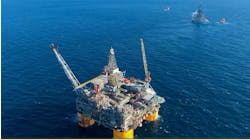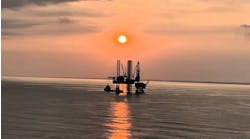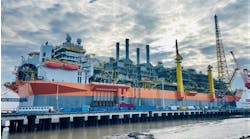Rick Von FlaternProblems have been few with the hydrocyclone desander installed earlier this year on Shell's Brent Delta platform in the North Sea, although the developers will make some changes. The unit's development was funded by Chevron, Lasmo, Shell, and Statoil through a joint industry project. [39,441 bytes]
Houston
Operators move carefully on downhole separation
Water, as a component of oil and gas production, has been a thorn in producers' sides since the industry began. Removing it is expensive and inconvenient, particularly offshore where processing equipment capital expenditures are compounded by the economic liabilities of space and weight. Also, in the offshore industry's delicate work environment, disposal of the unwanted water, once separated from the hydrocarbons, can be problematic.It would be expected then, that announcements of the development of downhole separation systems capable of handling large fluid volumes would meet with nothing less than wild enthusiasm among offshore operators. Alas, as Baker Tools' Chris Shore is all too aware, the oil business never has and probably never will race headlong into untried territory. Shore has been spending a great deal of his time perfecting Baker's downhole separator offering - the Hydro-Sep.
"The technology is very viable," Shore said. "The problem we are having is translating from the low risk category well, the simple low-flow, vertical, onshore well, to the higher risk, highly prolific, offshore type wells."
Allowing others to use their wells to prove new technology is a long-standing petroleum industry tradition. Shore understands. Operators of multi-millioin dollar wells are concerned with electric submersible pump reliability, how disposal zones will react over time, and the resulting high cost of offshore workovers should any of the complex technology and processes involved fail.
"The potential gains are enormous and payback is just a few days," Shore said. "But there are a lot of unknowns (in the operator's mind)." Surprisingly perhaps, the payoff from downhole separation is not so much in operating expense savings as from how removal of water downhole permits operators to draw individual wells down at maximum rate. And when water is not brought to the surface in highly water cut wells, other wells in the field can be produced at higher rates through liberated processing capacity.
With proper water-oil ratios, such as those commonly found in the North Sea where prolific wells are often 50% water-cut, payback for a downhole separation investment is about 30 days. In the worst case scenarios, according to Shore, when pumps are pummeled by sandy, gassy, or hot well fluids, run life can be expected to exceed 100 days.
"The average run life in the North Sea is over a year," Shore said. "So these guys could make a heap of money. It is just a matter of them doing their perceived risk levels."
Baker is not alone in downhole separator development. Pennwell's Ocean Oil Weekly newsletter recently reported the successful installation by Scotland-based Reda Production Services of its high-volume downhole separator system, Aqwanot, in an onshore field in Germany. Reda and Baker are, in fact, tied historically to subsurface separation developments begun at CFER.
Implementation of downhole separators offshore is inevitable. There is just too much money at stake. In one prolific area of the Norwegian sector, for example, where Baker is now working out the details of a probable installation, downhole separation could add up to 6,000 b/d of oil production. In some more mature fields on the UK side, the incremental increase will likely be less breathtaking, but still impressive, 300-400 b/d of oil. And as a nine-member, informal partnership of oil companies makes plans to test certain aspects of both Reda's and Baker's systems, it appears not even the test-it-somewhere-else mentality of the oil industry will stand up to those kind of numbers.
Risk wariness spurs a first
Some time ago Enserch picked up a gravel-pack screen completed well from Exxon. The new owners added two gravel packs with screens above the original one done at about 9,000 ft. Not long after, the well, located in the 2,150-ft waters of the Garden Banks 388 area of the Gulf of Mexico, began making sand and eventually plugged off.Fortunately, a tubing nipple had been installed just above the lower-most gravel pack. Enserch, suspecting the lowest zone to be the culprit, chose to wash to the nipple, set a plug, and bring the well back on. The plan seemed to have coiled tubing written all over it. But Enserch didn't see it that way and, in the interest of risk-reduction, opted for a snubbing unit instead.
The Enserch decision to implement the first planned, snubbing job performed from a floating vessel, revolved around - as does everything in the sometimes absurdly high-cost offshore drilling and production world - risk management. Snubbing operations of this type have a 95% success rate, meaning foremost, a significantly reduced chance of spending tens of millions in a replacement well, should something placed in the well become a permanent, if unwanted downhole fixture.
The plan worked. The well, having fallen to no production by the time the snubbers from Hydraulic Well Control arrived, was at 5,000 b/d when they left. The last reports indicate no significant sand production, a fair confirmation of the Enserch prognosis.
And just to make everyone look even a little smarter, the choice of a snubbing unit paid off in a way not originally expected when a stubborn PR plug hung in the hanger at 2,100 ft. Original plans called for it to be pulled by slickline. But junk on top and inside the internal fishing neck made it impossible to latch.
Then the tool, apparently surrounded by junk on the outside also, was so reluctant to move up hole that once it was caught, the pulling tool had to be pinned with a piece of chisel to prevent it shearing, when the force of the snubbing unit was brought to bear. The plug eventually came up, and the job brought to its successful conclusion. But had the coiled tubing been available, the crews might be there yet.
Good times slowing research
From the category of how-soon-they-forget: Companies were once keenly interested in taking the time and expense to show their wares to 18 oil companies, members of the oil industry consortium, DeepStar. Lately, such interest is as scarce as cable drilling rigs.Not along ago, the offshore industry research group commissioned Benton Baugh and his company, Radoil, to create and maintain a test loop to simulate five miles of subsea pipeline. The idea was to afford manufacturers an opportunity to show DeepStar their product's ability to remove hydrates and paraffins from deepwater pipelines - a major concern for all deepwater operators.
It sounded like a real opportunity at the time. But so far, the loop has received no challengers. Baugh thinks he knows why no one has come around, and he finds it difficult to feel bad about a lack of attendance under the circumstances.
"At this point there hasn't been anybody to come in for DeepStar to do testing," Baugh said from his office outside Houston. "They are all out wasting time, making money." Things could be, and very lately have been, worse.
Copyright 1997 Oil & Gas Journal. All Rights Reserved.


